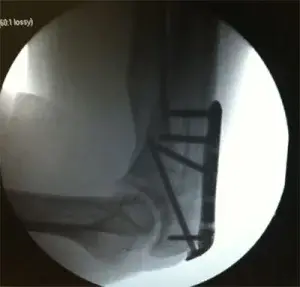OPIOID ADDICTION

We’ll start this article with some Dr. F self-disclosure. As you are looking at the X-ray of the handiwork of my orthopedic surgeon, try and realize the discussion I had regarding my fractured elbow:
- Wizard Orthopedic Surgeon at the University of Colorado Hospital – “I’m very sorry Dr. Fehling, you have an incredibly small fracture at the end of your elbow. The tendons and muscles may pull too much on it. I don’t believe it will heal well with that degree of pull. If it were up to me, I’d put a plate and screws in to stabilize your joint. If you get good healing, after one year I can go back in and take the hardware out!”
- Dr. Fehling – “Ok, if this needs to be done we’ll do it. Do you think I can still see my patients that day?”
One year later, I indeed had my elbow hardware removed and have an overall wonderful outcome to my elbow fracture (it was a bicycle accident, btw).
Surgical Hardware for Stabilization
When you are struggling with opioid addiction, it really is a full lifestyle. It overtakes your friendships, finances, career, loved ones, and general ‘brain real-estate.’ Addiction takes everything. The pull of these forces is very analogous to the tendon pull on my elbow. By stabilizing things with a medication such as Buprenorphine, you are able to address some of these healing points one by one. Most people ask about a buprenorphine or Suboxone taper. Ultimately, I tell them my opinion about how to succeed. If you make numerous changes in your life, you can essentially ‘earn’ your way off Buprenorphine. People who resist change tend to be kept on the med. Had my elbow shown poor overall healing, I’m sure the hardware would have stayed put. Buprenorphine is surgical hardware.
Efficacy
Buprenorphine treatment works. The medication has an overall strong effect size. Article analysis reviewing the efficacy of this medication includes some of the following clinical literature:
- Mattick, Richard P., et al. “Buprenorphine maintenance versus placebo or methadone maintenance for opioid dependence.” Cochrane Database Syst Rev 2.2 (2008).
- Buprenorphine is superior to placebo at retaining people in treatment at low (<8mg), medium (8-16mg) and high doses (16mg). Buprenorphine is superior to placebo at reducing heroin use at medium and high doses.
- Johnson, Rolley E., Jerome H. Jaffe, and Paul J. Fudala. “A controlled trial of buprenorphine treatment for opioid dependence.” Jama 267.20 (1992): 2750-2755.
- 20mg dose of Buprenorphine was superior to low dose methadone (20mg) for treatment retention and abstinence from heroin for a 25-week course of treatment.
- Ling, Walter, et al. “Buprenorphine maintenance treatment of opiate dependence: a multicenter, randomized clinical trial.” Addiction 93.4 (1998): 475-486.
- 8mg dose range of Buprenorphine was superior in treatment retention than at low dose (1mg) range. Both groups showed significant improvement in preventing death.
In reviewing multiple journal articles, there are common themes of Buprenorphine being very helpful for treatment retention, preventing opioid use at moderate or higher dose ranges, and preventing death. Buprenorphine is the standard of care for opioid addiction treatment today.
To Taper or Not to Taper?
After reviewing the above information and clinical content, we are left with the dilemma of determining how long a patient should be maintained on Buprenorphine and whether or not they should be tapered off the medication. Some of the clinical studies reviewing this are as follows:
- Fiellin, David A., et al. “Primary care-based buprenorphine taper vs maintenance therapy for prescription opioid dependence: a randomized clinical trial.” JAMA internal medicine 174.12 (2014): 1947-1954.
- After 6 weeks of Buprenorphine stabilization, people who were tapered off the medication over 3 weeks had significantly increased relapse on opioids, more opioid using days per week, and were less likely to complete the trial than were the Buprenorphine maintenance people.
- Sigmon, Stacey C., et al. “A randomized, double-blind evaluation of buprenorphine taper duration in primary prescription opioid abusers.” JAMA psychiatry 70.12 (2013): 1347-1354.
- Post-stabilization on Buprenorphine, prescription opioid-dependent people offered naltrexone medication after a 4-week taper did significantly better than those offered either 2 or 1-week tapers.
In terms of strategy involving Buprenorphine taper and then a bridge onto Naltrexone medication, the following study showed the most promising results:
- Umbricht, A., et al. “Naltrexone shortened opioid detoxification with buprenorphine.” Drug and alcohol dependence 56.3 (1999): 181-190.
- Starting naltrexone medication on day 2 of a buprenorphine taper led to higher dropout rates for the group but shorter overall withdrawal from buprenorphine (average 5 days) as compared to taking placebo medication while tapering buprenorphine.
What to Expect
This lets us believe that tapering off Buprenorphine is possible and can be done through different strategies. One study supported more of a 4-week rather than 1 or 2 week taper. The other study supported a 1-week taper combining with Naltrexone to speed up the transition.
It is important to note that the Naltrexone-aided taper would be best suited for a patient looking to bridge onto Naltrexone, an opioid blockade medication, for the first few months of being off Buprenorphine. This can ideally be done with the use of injectable Naltrexone (Vivitrol) to ensure compliance.
Supportive Medications
The most common additional medications prescribed to people progressing through a Buprenorphine taper include:
- Gabapentin
- Seroquel
- Clonidine
These medications tend to be safe for symptoms including sweating, agitation, insomnia, and anxiety. Of note, the only particularly dangerous med of these 3 is the clonidine, as it can cause severe hypotension and death when taken in excess. We counsel people to stay accurate with the prescription and not to expect a complete resolution of symptoms from something like clonidine. These medications will soften some of the withdrawal but are not powerful enough to completely take withdrawal away.
The only thing really powerful enough to take away Buprenorphine withdrawal is… Buprenorphine
The Realities of Tapering
Which leads us to a primary dilemma with this process. Buprenorphine tapers seem to only work when the medication is completely cut off from the patient, such as in residential treatment settings or with firm boundaries from a prescriber. Many people will work to taper down the medication and fail in their attempt. Most of the above-listed studies involved close monitoring of the medication and dispensing of doses through a center. This is different than with self-administered treatment approaches.
In connecting this to my fractured elbow example, an ideal patient to taper Buprenorphine would have the following traits:
- Minimum 6 months abstinence from opioids or heroin
- No presence of active opioid addiction in close family members
- Active enrollment in individual therapy or Peer Support
- Stable psychiatric issues such as depression or PTSD
- Minimal or no secondary substance use
- Adequate coping skills and emotional resilience for enduring the taper
Only if you meet the above-listed criteria, and that includes every single one of the above, you may be a good candidate to taper down your dosage. Talk to your provider about some of these issues so that you can build a collaborative plan moving forward. If any of the above are not applicable to you or are too difficult, the hardware needs to stay in.
